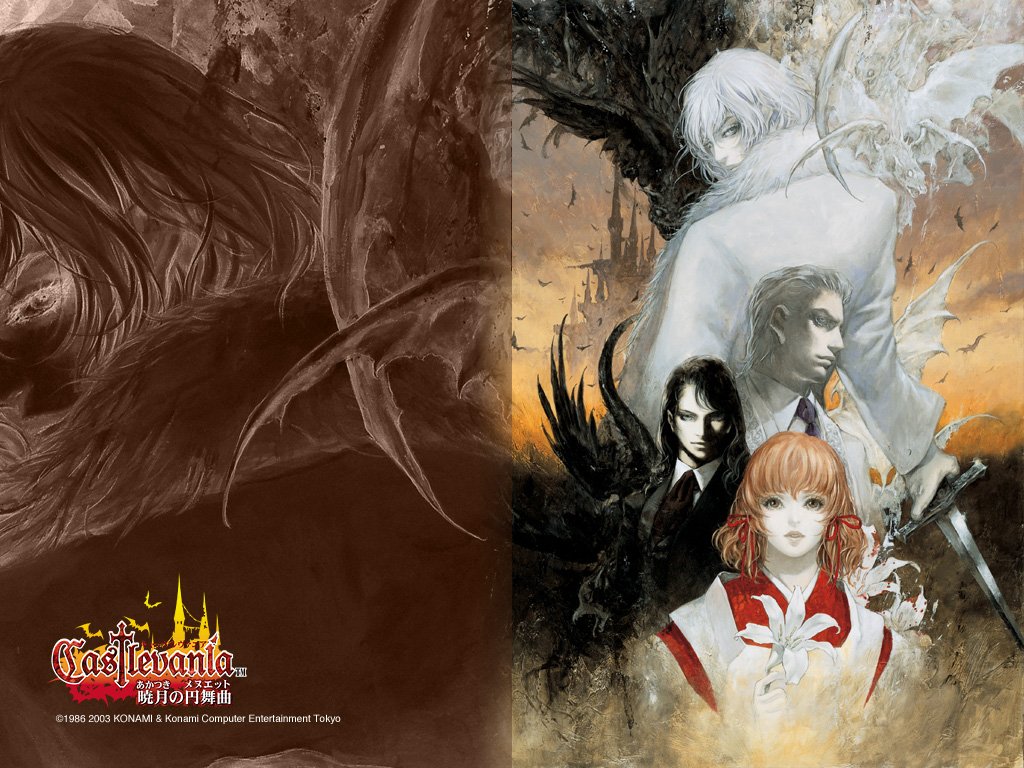[GBA] Castlevania: Aria of Sorrow
Castlevania: Aria of Sorrow is a 2003 side-scrolling platforming video game developed and published by Konami. It is the third installment of the Castlevania series on the Game Boy Advance. Producer Koji Igarashi, who had led the production teams for previous Castlevania titles, led Aria of Sorrow’s development as well. Michiru Yamane returned to compose the music for the game alongside Takashi Yoshida and Soshiro Hokkai. Director Junichi Murakami was new to the Castlevania series.
Aria of Sorrow is set in the year 2035, when Dracula has been sealed away after a battle in 1999. The plot follows the journey of Soma Cruz, a teenager granted occult power as a result of being a potential vessel of Dracula’s reincarnation, as he battles dark figures that wish to inherit the undead lord’s power. The game incorporates the same combination of elements from platform games and role-playing video games as in a previous game Castlevania: Symphony of the Night. Aria of Sorrow introduces several features to the series, such as the “Tactical Soul” system and employs a futuristic storyline in contrast to the medieval setting of many other Castlevania games. It was released in May 2003 for the Game Boy Advance.
Although Aria of Sorrow sold poorly in Japan, selling 27,000 units nearly one month after its release, it was commercially successful in the United States, with more than 158,000 units sold in the three months following its release. Aria of Sorrow received universal acclaim with praise going towards its visuals, gameplay (particularly the Tactical Soul System), music, and level design with some even considering to be the best game in the Castlevania series since Symphony of the Night. Konami released a sequel to Aria of Sorrow, Castlevania: Dawn of Sorrow, on August 25, 2005 in Japan. It incorporated many elements from its predecessor, including the “Tactical Soul” system. Aria of Sorrow was re-released as part of Konami’s “Konami the Best” line on November 3, 2005 in Japan, and in a dual pack with Harmony of Dissonance, titled the Castlevania Double Pack, in North America on January 11, 2006.

Aria of Sorrow features a 2D side-scrolling style of gameplay where the player controls the onscreen character from a third-person perspective to interact with people, objects, and enemies. Like previous games in the series and most role-playing video games, characters level up each time they earn a set number of experience points from defeating enemies; each “level” gained increases the character’s statistics, thus improving their performance in battle. Statistic examples include hit points, the amount of damage a character can receive; magic points, which determine the number of times a character can use magical attacks; strength, the power of a character’s physical attacks; and intelligence, the power of a character’s magical spells. Upon encountering an enemy, the player can use a variety of weapons to attack and defeat the enemy. Despite the game being set in 2035, the available weapons are largely medieval, including swords, axes, and spears; though a handgun is available. These weapons differ in their damage output, the range of the weapon, and the speed of the attack. Items and other accessories can be found by defeating enemies or by purchasing items from the game’s shop.
Similar to previous games in the series, Aria of Sorrow is set within Dracula’s castle, which is divided into several areas that the player traverses. These areas feature different components, such as different enemies, varying terrain characteristics, and a unique piece of theme music. Similar to most platform games, progression between areas is limited by the abilities the player has. While the method in which the player progresses through the game is initially linear, the player’s options become more diverse as the number of character abilities increases.
DOWNLOAD: Castlevania: Aria of Sorrow
BACKUP LINK: Castlevania: Aria of Sorrow








